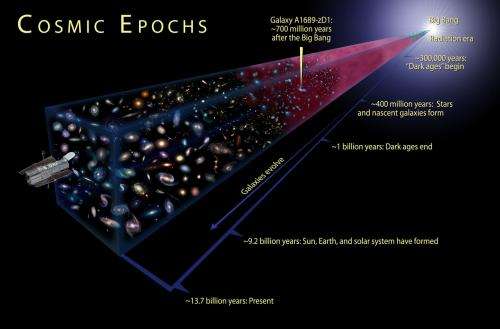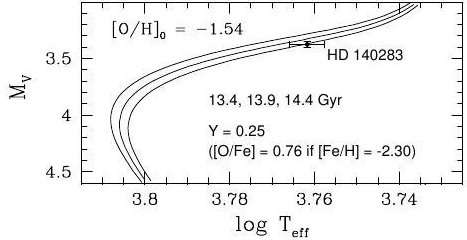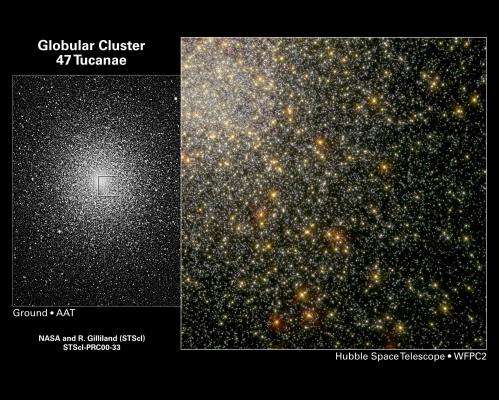Nearby ancient star is almost as old as the Universe

A metal-poor star located merely 190 light-years from the Sun is 14.46+-0.80 billion years old, which implies that the star is nearly as old as the Universe! Those results emerged from a new study led by Howard Bond. Such metal-poor stars are (super) important to astronomers because they set an independent lower limit for the age of the Universe, which can be used to corroborate age estimates inferred by other means.
In the past, analyses of globular clusters and the Hubble constant (expansion rate of the Universe) yielded vastly different ages for the Universe, and were offset by billions of years! Hence the importance of the star (designated HD 140283) studied by Bond and his coauthors.
"Within the errors, the age of HD 140283 does not conflict with the age of the Universe, 13.77 ± 0.06 billion years, based on the microwave background and Hubble constant, but it must have formed soon after the big bang." the team noted.
Metal-poor stars can be used to constrain the age of the Universe because metal-content is typically a proxy for age. Heavier metals are generally formed in supernova explosions, which pollute the surrounding interstellar medium. Stars subsequently born from that medium are more enriched with metals than their predecessors, with each successive generation becoming increasingly enriched. Indeed, HD 140283 exhibits less than 1% the iron content of the Sun, which provides an indication of its sizable age.

HD 140283 had been used previously to constrain the age of the Universe, but uncertainties tied to its estimated distance (at that time) made the age determination somewhat imprecise. The team therefore decided to obtain a new and improved distance for HD 140283 using the Hubble Space Telescope (HST), namely via the trigonometric parallax approach. The distance uncertainty for HD 140283 was significantly reduced by comparison to existing estimates, thus resulting in a more precise age estimate for the star.
The team applied the latest evolutionary tracks (basically, computer models that trace a star's luminosity and temperature evolution as a function of time) to HD 140283 and derived an age of 14.46+-0.80 billion years (see figure above). Yet the associated uncertainty could be further mitigated by increasing the sample size of (very) metal-poor stars with precise distances, in concert with the unending task of improving computer models employed to delineate a star's evolutionary track. An average computed from that sample would provide a firm lower-limit for the age of the Universe. The reliability of the age determined is likewise contingent on accurately determining the sample's metal content. However, we may not have to wait long, as Don VandenBerg (UVic) kindly relayed to Universe Today to expect, "an expanded article on HD 140283, and the other [similar] targets for which we have improved parallaxes [distances]."

As noted at the outset, analyses of globular clusters and the Hubble constant yielded vastly different ages for the Universe. Hence the motivation for the Bond et al. 2013 study, which aimed to determine an age for the metal-poor star HD 140283 that could be compared with existing age estimates for the Universe. The discrepant ages stemmed partly from uncertainties in the cosmic distance scale, as the determination of the Hubble constant relied on establishing (accurate) distances to galaxies. Historical estimates for the Hubble constant ranged from 50-100 km/s/Mpc, which defines an age spread for the Universe of ~10 billion years.
The aforementioned spread in Hubble constant estimates was certainly unsatisfactory, and astronomers recognized that reliable results were needed. One of the key objectives envisioned for HST was to reduce uncertainties associated with the Hubble constant to <10%, thus providing an improved estimate for the age of the Universe. Present estimates for the Hubble constant, as tied to HST data, appear to span a smaller range (64-75 km/s/Mpc), with the mean implying an age near ~14 billion years.
Determining a reliable age for stars in globular clusters is likewise contingent on the availability of a reliable distance, and the team notes that "it is still unclear whether or not globular cluster ages are compatible with the age of the Universe [predicted from the Hubble constant and other means]." Globular clusters set a lower limit to the age of the Universe, and their age should be smaller than that inferred from the Hubble constant (& cosmological parameters).
In sum, the study reaffirms that there are old stars roaming the solar neighborhood which can be used to constrain the age of the Universe (~14 billion years). The Sun, by comparison, is ~4.5 billion years old.
The team's findings will appear in the Astrophysical Journal Letters, and a preprint is available on arXiv.
More information: iopscience.iop.org/2041-8205/
Journal information: Astrophysical Journal Letters
Source: Universe Today




















